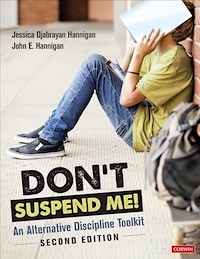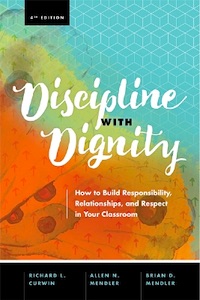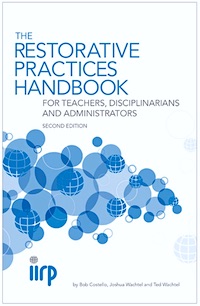3 Tools That Improve Long-Term Behaviors
At the beginning of my education career, I didn’t think a lot about discipline. I focused on creating a community of readers and writers.
In fact, I didn’t see a lot of misbehaviors, so why spend much time researching how I might address my more challenging students? If my classroom management and a call home didn’t stop the problem, I’d write a detention or office referral and move on.
Boy, do I wish I could hop into a time machine and tell my past self all about alternative discipline!
I initially got a taste for it in a Positive Behavior Interventions and Supports (PBIS) training where I learned about resources like PBISWorld.com. It was the first time I had been exposed to the idea of tiered behavior and addressing the behavior with interventions.
And Then I Became the Disciplinarian
When I became an assistant principal, my entire paradigm shifted. Discipline was my responsibility and it became an opportunity for me to equip students with skills they need for life.
Discipline isn’t a disruption of learning, just another opportunity to learn. A detention or office referral doesn’t build empathy or help students develop self-control or show them how to resolve conflict. But reflective and restorative practices do!
Reflective Practices in the Pandemic
When the world transitioned to online learning, I knew I needed to rethink our school’s system of consequences. Detentions and suspensions were no longer an option in the online world. And when students returned face-to-face, I wanted to keep students in the classroom as often as possible so they didn’t miss the instruction they so desperately needed.

The Hannigans’ toolkit has ready-made reflection sheets, assignments, and resources targeting a variety of behavior infractions. For example, when a student doesn’t use appropriate language either on the digital discussion boards or in the physical classroom, I simply flip to the section on inappropriate language.
There I can find a variety of tools, including:
- a reflection sheet for students to use that requires them to brainstorm alternatives to the inappropriate words;
- assignments like interviewing others to find out how inappropriate language makes them feel; or
- the option to have the student research and prepare a PowerPoint presentation for younger students about how to communicate respectfully.
With the toolkit, I can literally just copy the reflection sheet and hand it to the student. I also like to require students to show their completed reflection page to their parents, have a conversation about the issue, write what they and their parents talked about, and have the parent sign.
Reflections can be used in place of detention or paired with them. During detention, students can reflect on the impact of their actions and how they might make better choices in the future. You can even customize the reflections to tie into the campus or district mission and vision.
Behavior Agreements
For students who are my “frequent flyers,” I like to use Behavior Agreements. I call them agreements instead of contracts because student ownership leads to better results. After doing both behavior and academic agreements over the years, I’m always struck by the magic of having kids sign a paper!
To create the agreement, I sit down with a student and have them reflect on the two to three behaviors that prevent them from being successful. I type up an agreement targeting those behaviors on official school letterhead.
Within the agreement is a clearly defined list of consequences of first, second, and third infractions as well as a defined reward when the student is successful within a specific time frame.
Real talk: My past-self would have scoffed at the idea of rewarding a student for behaving appropriately. But now that I’ve reframed discipline as guiding a student to change behaviors for the long-term, I see where reinforcers of proper behavior make sense.

When an adult hits a weight loss milestone, they may reward themselves with a new pair of shoes or a special treat. Coming up with a reward to celebrate can be just as important as we guide students to better behavior as applying a consequence when they slip up.
Dr. Laura Riffel (Behavior Doctor Seminars) has compiled a large list of reinforcers – many of which are non-tangibles! It always warms my heart when students select positive phone calls to parents or a certificate showing they are improving. Students want to be successful, and they want us to be able to tell them we are proud of them!
Restorative Chats
Even if your class does not regularly “circle up,” the protocol for restorative chats can be used when a student has damaged a relationship. The chat is a non-confrontational way to restore the relationship and build empathy in the offender. It’s also an excellent solution-seeking model – the student can talk about conflict when both parties are calm.

If you have a student in class who repeatedly shows disrespect to you or peers, a restorative chat may be an effective intervention. Some students respond to the chat for a couple of weeks and then revert back to old behaviors, so don’t feel you did it incorrectly if you have to have a chat with a student multiple times throughout the year.
Not New But Needed
Reflective and restorative practices are not new. However, the pandemic has created an even greater need to use discipline as a tool to support a child’s social-emotional needs and development.
Students who may have gone over a year without working with peers may need even more assistance in navigating conflict. Students who spent months playing video games when they should have been paying attention to a lesson may struggle all the more with self-control.
Every educator invested in a student’s future success can see opportunities to use these practices to create lasting behavior changes.
Sara Johnson (@guidingon) learned a lot about discipline practices as a middle school assistant principal in Fort Bend, TX before, during and after the pandemic. She is currently the district’s Secondary ELA Curriculum Coordinator. Sara has also been an elementary digital learning specialist, an Abydos Learning International trainer, and a middle grades English Language Arts teacher.
Sara’s blog Guiding On the Side (2014-2020) is still available online and shares many tips, strategies and thoughtful discussions. She’s also on YouTube, and presents at various conferences throughout Texas. Sara is a life-long learner with a passion for reading/writing workshop, blended learning, and otters. Her husband and daughter are two of the coolest people she knows.
































Thanks for the timely article and the great resource tips, Sara. What a sensible approach to helping students self-discipline — our ultimate goal.